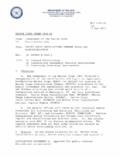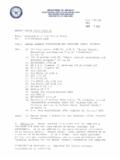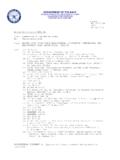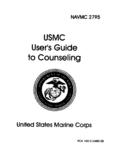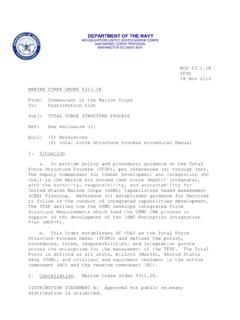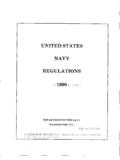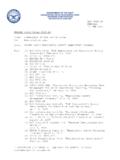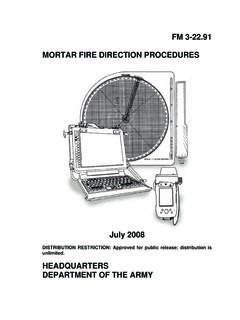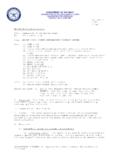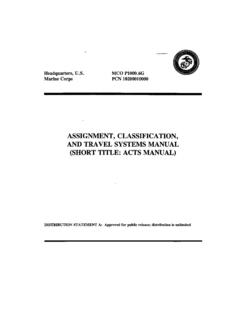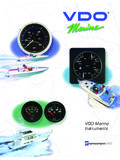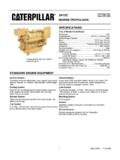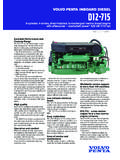Transcription of DEPARTMENT OF THE NAVY HEADQUARTERS UNITED …
1 DEPARTMENT OF THE NAVY HEADQUARTERS UNITED STATES MARINE CORPS 3000 MARINE CORPS PENTAGON WASHINGTON, DC 20350- 3000 MARINE CORPS ORDER From: Commandant of the Marine Corps To: Distribution List Subj: GROUND EQUIPMENT MAINTENANCE PROGRAM (GEMP) Ref: (a) MCDP 1 - 0 (b) MCO (c-) DODD (d) DODI (e) CJCSI 3170. 01H (f) MCO (g) MCO (h) MCO P3121. 1 ( i) DODD ( j ) DODI (k) DODM M ( l) DODI (m) DODD (n) MCO ( 0) DODI (p) DODI 4140. 1 (q) DOD ( r) MCO ( s) MCO W/CH 2 ( t) MCO W/ERRATUM CH 1-2 (u) MCO W/CH 1-2 (v) MCO W/CH 1 (w) DODD (x) MCO W/CH 1 (y) MCO ( z) MCWP 3-40. 1 (aa) MCO (ab) MCO (ac) MCO 5215. 1K (ad) SECNAV- M 5210.
2 1 MCO LPC 12 Jan 2014 DISTRIBUTION STATEMENT A : Approved for public release; distribution is unlimited. MCO 12 Jan 2014 1. Situation. The Ground Equipment Maintenance Program (GEMP) includes activities required to meet DEPARTMENT of Defense (DOD) and Marine Corps readiness, logistics, and sustainability objectives that enable the Marine Corps to maintain operational capabilities per reference (a) . As performance requirements for ground equipment continue to increase in order to keep pace with evolving defense strategies and operational concepts of employment, the Marine Corps must continuously improve ground equipment acquisition, sustainment and maintenance practices in order to sustain these capabilities.
3 Roles and responsibilities of Marine Corps' agencies identified in this Order provide an integrated framework for a Total Productive Maintenance (TPM) strategy that supports Continuous Process Improvement (CPI) across the full range of actions required to maintain and sustain ground equipment, from initial requirements determination to final asset disposition. The Marine Corps' TPM strategy supports effective Total Life Cycle Management (TLCM) that is described in reference (b) by supporting or enabling the following actions: a. Ensures planning in the development and acquisition of combat systems incorporates reliability and maintenance considerations, and that it is informed and supported by meaningful systems performance and maintenance data feedback from the operating forces in accordance with references (c) through (g).
4 B. Incorporates all facets of maintenance management into the Planning, Programming, Budgeting and Execution (PPBE) process per reference (h) , in order to ensure funding is appropriately applied to support TLCM. c. Integrates Condition Based Maintenance Plus (CBM+) concepts and the Reliability-Centered Maintenance (RCM) process described in references (i) through (k) into acquisition and sustainment planning and maintenance management decision processes supporting TLCM. d. Maximizes the effective use of field, depot and Original Equipment Manufacturing (OEM) capacities and capabilities through effective maintenance management decision processes that increase unit readiness as reported per references (1) through (n) e.
5 Informs supply chain management and supports leveraging concepts including Serialized Item Management (SIM), stock positioning, and distribution, as defined in references (o) 2 MCO 12 Jan 2014 through (v), to ensure effective materiel support of maintenance processes. f. Supports CPI, as defined in reference (w), by identifying, reporting and correcting materiel deficiencies and technical information management practices described in references (x) and (y), which are essential to effective materiel management. 2. Cancellation. MARADMIN 159/13, Levels of Maintenance. 3. Mission. Establish a sustainable maintenance program for Marine Corps' operational forces and supporting activities that incorporates a TPM strategy that includes integration of CBM+ concepts and the RCM process in order to facilitate CPI of maintenance planning, management, operations, engineering, and reporting practices.
6 4. Execution a. Commander's Intent. To promulgate guidance on the Marine Corps' maintenance strategy to integrate enterprise-wide efforts in TLCM of equipment and weapon systems. This will be accomplished by clearly defining the respective roles and responsibilities of Marine Corps agencies for TLCM, and through implementation of a TPM strategy throughout the field and depot levels of maintenance. This strategy will leverage people, processes and technologies to improve TLCM by integrating CBM+ and RCM within the Marine Corps' maintenance program. The strategy will be enabled by enhanced data collection and information management practices and technologies that will provide maintenance managers, program managers and operational planners the right information required to support effective materiel management decision making.
7 Implementation of a systemic and integrated GEMP ensures maximum materiel reliability, availability, and maintainability through the below key elements: (1) Defined roles and responsibilities that govern identification of sustainment Key Performance Parameters (KPP) and Key System Attributes (KSA), per reference (e), which are consistent with Marine Corps maintenance goals and objectives. (2) Defined roles and responsibilities that govern maintenance planning decisions during acquisition and use of maintenance related personnel, materiel, facilities, and funding for sustainment of Marine Corps ground equipment. 3 MCO 12 Jan 2014 (3) Enhanced maintenance efficiency and effectiveness throughout equipment life cycle, and increased ability for life cycle management to inform requirements generation processes.
8 (4) Integrated and proactive .maintenance training and readiness practices for operators and maintainers which minimize unscheduled repairs, eliminate unnecessary maintenance actions, and employ the most cost-effective methods of maintenance planning and operations. (5) Implementation of RCM analyses, and CBM+ concepts within the integrated TLCM framework in order to increase materiel availability. (6) Implementation of systematic data collection and information reporting requirements to measure and respond to maintenance program metrics throughout life cycle planning, execution, and sustainment. (7) Disciplined collection, analysis, identification of source of funding and communication of equipment failure data to inform development of procedural or design modifications that will improve reliability by ensuring that equipment meets target performance objectives.
9 (8) Expanded access to timely and accurate technical and historical usage and maintenance data that supports effective maintenance decision making, across the enterprise, required to minimize materiel downtime and extend life cycle. (9) Efficient leveraging of support from inter-service, joint, and industry maintenance capabilities. b. Concept of Operations. The Deputy Commandant (DC) Installations and Logistics (I&L) will develop policy supporting the GEMP, ensure integration of GEMP concepts within TLCM plans and programs, and govern implementation of and compliance with the TPM strategy throughout the Marine Corps. (1) Total Productive Maintenance (TPM) TPM is a comprehensive approach to maintenance intended not only to prevent and correct equipment failures, but also to optimize equipment performance and extend equipment life cycle.
10 In TPM, responsibility for maintenance extends throughout an organization, with operators and maintainers cooperating to predict, prevent, diagnose and correct equipment failures, and to provide feedback to improve maintenance plans and equipment 4 MCO 12 Jan 2014 design and modification to increase performance and reliability. The GEMP includes the following elements of TPM: (a) Use of metrics to assess and measure equipment performance against established standards and to assess and measure maintenance performance. (b) Preventive and corrective maintenance performed by crew/operators and maintainers. (c) Communication among crew/operators and maintainers to assess equipment condition and performance, and to diagnose and correct deficiencies or failures.
